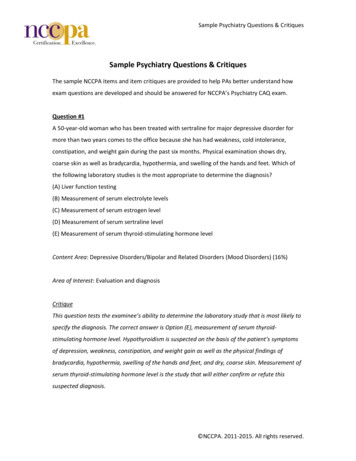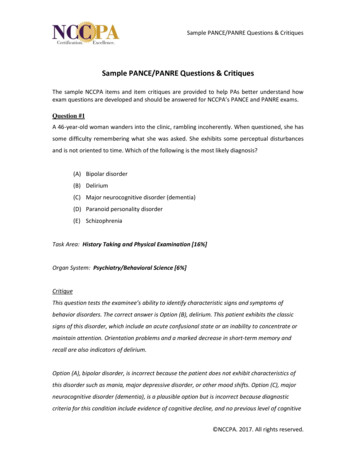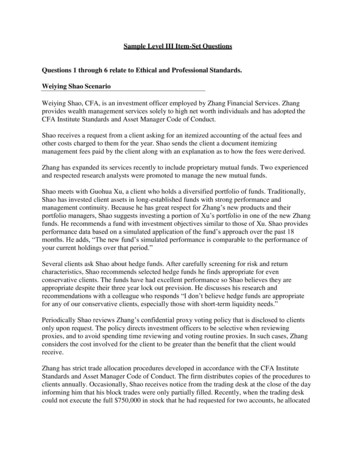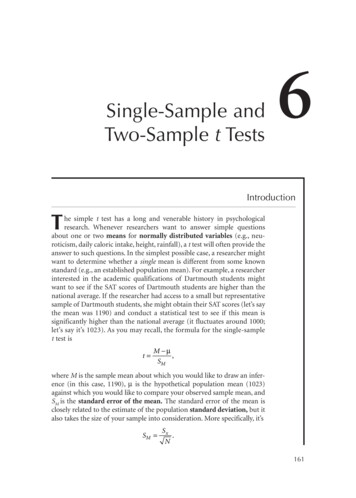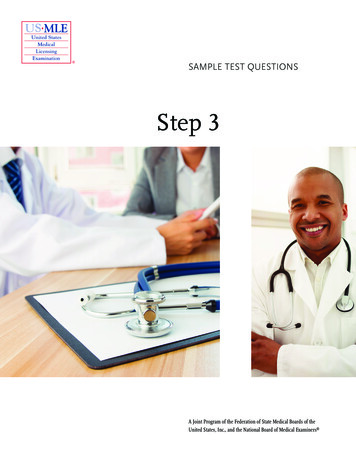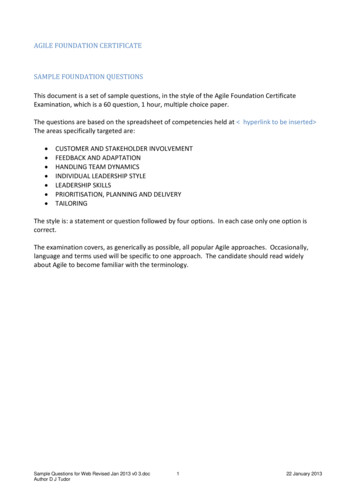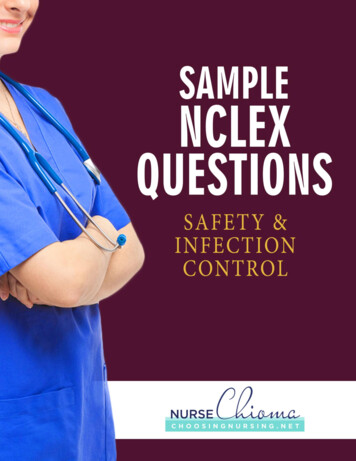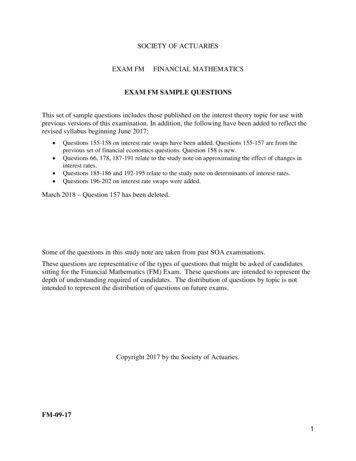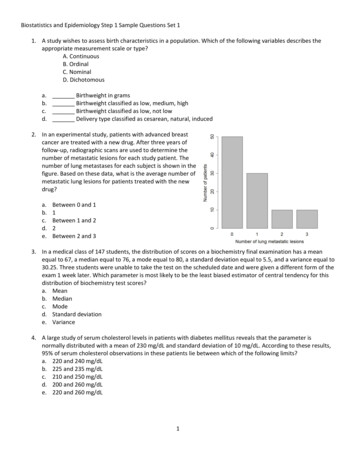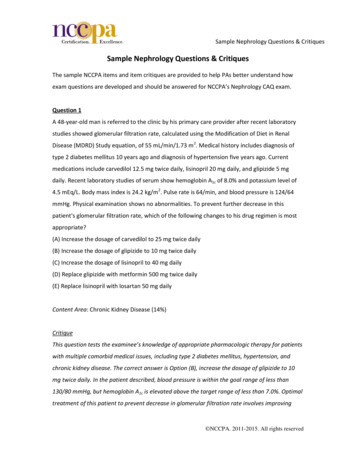
Transcription
Sample Nephrology Questions & CritiquesSample Nephrology Questions & CritiquesThe sample NCCPA items and item critiques are provided to help PAs better understand howexam questions are developed and should be answered for NCCPA’s Nephrology CAQ exam.Question 1A 48-year-old man is referred to the clinic by his primary care provider after recent laboratorystudies showed glomerular filtration rate, calculated using the Modification of Diet in RenalDisease (MDRD) Study equation, of 55 mL/min/1.73 m2. Medical history includes diagnosis oftype 2 diabetes mellitus 10 years ago and diagnosis of hypertension five years ago. Currentmedications include carvedilol 12.5 mg twice daily, lisinopril 20 mg daily, and glipizide 5 mgdaily. Recent laboratory studies of serum show hemoglobin A1c of 8.0% and potassium level of4.5 mEq/L. Body mass index is 24.2 kg/m2. Pulse rate is 64/min, and blood pressure is 124/64mmHg. Physical examination shows no abnormalities. To prevent further decrease in thispatient's glomerular filtration rate, which of the following changes to his drug regimen is mostappropriate?(A) Increase the dosage of carvedilol to 25 mg twice daily(B) Increase the dosage of glipizide to 10 mg twice daily(C) Increase the dosage of lisinopril to 40 mg daily(D) Replace glipizide with metformin 500 mg twice daily(E) Replace lisinopril with losartan 50 mg dailyContent Area: Chronic Kidney Disease (14%)CritiqueThis question tests the examinee’s knowledge of appropriate pharmacologic therapy for patientswith multiple comorbid medical issues, including type 2 diabetes mellitus, hypertension, andchronic kidney disease. The correct answer is Option (B), increase the dosage of glipizide to 10mg twice daily. In the patient described, blood pressure is within the goal range of less than130/80 mmHg, but hemoglobin A1c is elevated above the target range of less than 7.0%. Optimaltreatment of this patient to prevent decrease in glomerular filtration rate involves improving NCCPA. 2011-2015. All rights reserved
Sample Nephrology Questions & Critiquesglycemic control. Increasing the dosage of glipizide is the change in the patient’s drug regimenthat is most likely to decrease the hemoglobin A1c level.Option (A), increase the dosage of carvedilol to 25 mg twice daily, and Option (C), increase thedosage of lisinopril to 40 mg daily, are incorrect because the patient’s blood pressure is withinthe goal range. Option (D), replace glipizide with metformin 500 mg twice daily, is incorrectbecause metformin should not be used in patients with decreased glomerular filtration rate.Option (E), replace lisinopril with losartan 50 mg daily, is incorrect because the patient iscurrently being treated with an angiotensin-converting enzyme inhibitor (lisinopril), which ismore appropriate therapy for control of blood pressure than an angiotensin II receptor blocker(losartan) because of its effect of slowing progression of chronic kidney disease.Question 2A 65-year-old woman with stage 4 chronic kidney disease secondary to hypertension comes tothe office because she has had dysuria and increased urinary frequency during the past twodays. She has not had fever or hematuria. Temperature is 37.3 C (99.1 F), pulse rate is 90/min,and blood pressure is 142/85 mmHg. On physical examination, no flank tenderness is noted.Urinalysis shows cloudy urine that is positive for leukocyte esterase, nitrites, and protein.Results of urine culture are pending. Which of the following medications is the most appropriatetherapy for this patient's condition?(A) Intramuscular administration of ceftriaxone(B) Intravenous administration of gentamicin(C) Intravenous administration of vancomycin(D) Oral administration of ciprofloxacin(E) Oral administration of nitrofurantoinContent Area: Chronic Kidney Disease (14%)CritiqueThis question tests the examinee’s ability to identify the disorder, consider the most likely cause,and then determine the most appropriate therapy considering the underlying condition of stage NCCPA. 2011-2015. All rights reserved
Sample Nephrology Questions & Critiques4 chronic kidney disease. The correct answer is Option (D), oral administration of ciprofloxacin.The patient’s symptoms, physical examination findings, and results of urinalysis are consistentwith urinary tract infection, and Escherichia coli is the most likely pathogen. On the basis of thecausative organism and the options presented, oral administration of ciprofloxacin is the mostappropriate management of urinary tract infection in the patient described.Option (A), intramuscular administration of ceftriaxone, and Option (C), intravenousadministration of vancomycin, are incorrect because these are not appropriate first-linetherapies for uncomplicated urinary tract infection. Option (B), intravenous administration ofgentamicin, is incorrect because this therapy is not appropriate initial management ofuncomplicated urinary tract infection. In addition, because gentamicin is nephrotoxic, it shouldnot be used in patients with chronic kidney disease. Option (E), oral administration ofnitrofurantoin, is incorrect because it is contraindicated and is ineffective therapy for urinarytract infection in patients with stage 4 chronic kidney disease.Question 3A 36-year-old woman with diabetic nephropathy comes to the office for follow-up. During theinterview, the patient says she has had fatigue for the past month. Physical examination showspallor and pale conjunctivae, a grade 2/6 systolic murmur that is heard best over the left lowersternal border, and bilateral mild, pitting edema of the lower extremities. Laboratory studiesshow hemoglobin level of 9.8 g/dL and estimated glomerular filtration rate, calculated using theModification of Diet in Renal Disease (MDRD) Study equation, is 19 mL/min/1.73 m2. Therapywith an erythropoiesis-stimulating agent is initiated. Which of the following is the targethemoglobin level for this patient?(A) 7-8 g/dL(B) 9-10 g/dL(C) 11-12 g/dL(D) 13-14 g/dL(E) 15-16 g/dLContent Area: Chronic Kidney Disease (14%) NCCPA. 2011-2015. All rights reserved
Sample Nephrology Questions & CritiquesCritiqueThis question tests the examinee’s ability to review a detailed clinical scenario and determine theappropriate target hemoglobin level for the patient described. The correct answer is Option (C),11-12 g/dL. The patient’s symptoms of pallor, pale conjunctivae, and systolic murmur areconsistent with anemia, which is confirmed by the laboratory findings. In a patient with chronickidney disease, anemia is most likely secondary to the disease process. Current National KidneyFoundation (NKF) Kidney Disease Outcomes Quality Initiative (KDOQI) and Kidney Disease:Improving Global Outcomes (KDIGO) guidelines specify an optimal target range for hemoglobinlevel of 11-12 g/dL.Option (A), 7-8 g/dL, and Option (B), 9-10 g/dL, are incorrect because hemoglobin levels lowerthan the target range are insufficient to alleviate symptoms of anemia. Option (D), 13-14 g/dL,and Option (E), 15-16 g/dL, are incorrect because hemoglobin levels higher than the target rangeare associated with increased morbidity and mortality.Question 4A 54-year-old woman with diabetic nephropathy comes to the office because she has hadvomiting, anorexia, fatigue, itching, and a metallic taste in her mouth for the past two weeks.Respirations are 32/min. Physical examination shows urine-like odor of the breath and 2 pittingedema. Estimated glomerular filtration rate, calculated using the Modification of Diet in RenalDisease (MDRD) Study equation, is 14 mL/min/1.73 m2. Additional studies in this patient aremost likely to show presence of which of the following conditions?(A) Hypokalemia(B) Primary metabolic acidosis(C) Primary metabolic alkalosis(D) Primary respiratory acidosis(E) Primary respiratory alkalosisContent Area: Renal Pathophysiology (15%) NCCPA. 2011-2015. All rights reserved
Sample Nephrology Questions & CritiquesCritiqueThis question tests the ability of the examinee to associate acid-base abnormalities with specificmedical conditions. The correct answer is Option (B), primary metabolic acidosis. The patient’shistory includes several risk factors for an acid-base abnormality. Chronic kidney disease,diabetes mellitus, and vomiting all lead to primary metabolic acidosis.Option (A), hypokalemia, is incorrect because as chronic kidney disease progresses, thedistal nephron loses the ability to secrete potassium ions, most often leading to hyperkalemia.Option (C), primary metabolic alkalosis, is incorrect because the progression of chronic kidneydisease leads to distal renal tubular acidosis — marked by low blood pH, not elevated pH as seenin alkalosis. Option (D), primary respiratory acidosis, is incorrect because this condition is causedby elevated pCO2, not buildup of hydrogen and chloride ions in the blood. Option (E), primaryrespiratory alkalosis, is incorrect because although a degree of respiratory alkalosis may developin patients with chronic kidney disease, it is compensatory in nature and is not the primarydisorder.Question 5A 56-year-old man with a long history of alcohol use is admitted to the hospital after he had aseizure that was witnessed by his wife. The patient is obtunded, swollen, and jaundiced.Temperature is 36.8 C (98.3 F), pulse rate is 104/min and regular, respirations are 18/min, andblood pressure is 104/62 mmHg. On physical examination, auscultation of the chest showsdiminished breath sounds. Examination of the abdomen shows firmness of the right upperquadrant, palpable hepatomegaly, and protuberance of the umbilicus. Results of laboratorystudies of serum include the following:CreatinineSodiumPotassiumBlood urea nitrogen0.8 mg/dL108 mEq/L3.5 mEq/L4 mg/dLWhich of the following is the most appropriate initial management?(A) Emergent hemodialysis NCCPA. 2011-2015. All rights reserved
Sample Nephrology Questions & Critiques(B) Fluid restriction(C) Intravenous administration of 3% saline(D) Intravenous administration of 5% dextrose in water(E) Intravenous administration of diltiazem (Cardizem)Content Area: Renal Pathophysiology (15%)CritiqueThis question tests the examinee’s ability to determine the most appropriate initial managementbased on symptoms, history, and laboratory findings. The correct answer is Option (C),intravenous administration of 3% saline. The presenting symptom of mental status changesalong with the physical examination and laboratory findings indicate that the seizure was mostlikely secondary to hyponatremia. More rapid increase in serum sodium level is indicated inpatients with hyponatremia when neurologic manifestations are present. Therefore, the mostappropriate initial management of the patient’s condition is an intervention that will elevatesodium levels — intravenous administration of 3% saline.Option (A), emergent hemodialysis, is incorrect because no indicators for this therapy arepresent. Option (B), fluid restriction, is incorrect because although this intervention willultimately cause a proportional increase in the serum sodium level, the patient’s mental statuschanges and seizure activity warrant more rapid increase than fluid restriction alone couldprovide. Option (D), intravenous administration of 5% dextrose in water, is incorrect because thistherapy will decrease the serum sodium level. Also, this therapy is not most appropriate becausethe patient’s seizure was not secondary to hypoglycemia. Option (E), intravenous administrationof diltiazem (Cardizem), is incorrect because this therapy will not increase the serum sodium leveland because it is indicated for arrhythmia, which is not present.Question 6A 67-year-old man with stage 4 chronic kidney disease, hypertension, type 2 diabetes mellitus,and anemia of chronic kidney disease comes to the office for routine follow-up. Laboratoryfindings include the following: NCCPA. 2011-2015. All rights reserved
Sample Nephrology Questions & eFasting glucosePhosphateAlbuminBlood urea nitrogenHematocritHemoglobinMean corpuscular volume9.4 mg/dL3.24 mg/dL3.8 mEq/L19 mEq/L63 mg/dL4.2 mg/dL4.0 g/dL36 mg/dL33.1%11.1 g/dL94 µm3Estimation of glomerular filtration rate, calculated using the Modification of Diet in RenalDisease (MDRD) Study equation, is 19 mL/min/1.73 m2. Measurement of which of the followingadditional laboratory values is most appropriate to screen for renal osteodystrophy in thispatient?(A) Erythrocyte sedimentation rate(B) Serum C-reactive protein level(C) Serum intact parathyroid hormone level(D) Serum thyroid-stimulating hormone level(E) Serum vitamin B12 levelContent Area: Renal Pathophysiology (15%)CritiqueThis question tests the examinee’s ability to determine the cause of a condition, based on historyand laboratory findings, as well as knowledge of guidelines and appropriate testing for mineralbone disease in patients with chronic kidney disease. The correct answer is Option (C), serumintact parathyroid hormone level. In the patient with stage 4 chronic kidney disease andcorresponding abnormal laboratory values, the pathophysiologic response represents mineralbone disease and depletion of serum calcium. The National Kidney Foundation (NKF) KidneyDisease Outcomes Quality Initiative (KDOQI) recommends measurement of serum parathyroidhormone level and therapy for abnormal values to prevent and manage mineral bone disease.Option (A), erythrocyte sedimentation rate, and Option (B), serum C-reactive protein level, are NCCPA. 2011-2015. All rights reserved
Sample Nephrology Questions & Critiquesincorrect because these are markers of inflammation and are not useful in diagnosing mineralbone disease. Option (D), serum thyroid-stimulating hormone level, is incorrect because this testis used for diagnosing primary and secondary hyperthyroidism and hypothyroidism, not mineralbone disease. Option (E), serum vitamin B12 level, is incorrect because this test would beapprop
Question 1 A 48-year-old man is referred to the clinic by his primary care provider after recent laboratory studies showed glomerular filtration rate, calculated using the Modification of Diet in Renal Disease (MDRD) Study equation, of 55 mL/min/1.73 m2. Medical history includes diagnosis of type 2 diabetes mellitus 10 years ago and diagnosis of hypertension five years ago. Current medications .
